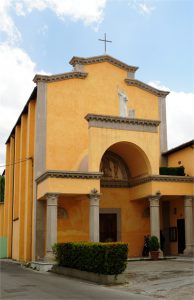 Titolare: San Giovanni Evangelista
Titolare: San Giovanni Evangelista
Unità Pastorale di San Giuliano Terme
Indirizzo della Parrocchia: Via Matteotti, 29 – Gello; 56017 San Giuliano Terme (PI)
PARROCO: GRZYWACZ Mons. TOMASZ
Abitazione del Parroco: Via Matteotti, 29 – Gello; 56017 San Giuliano Terme (PI)
Telefono del Parroco: +39.366.2447198 (WhatsApp)
E-mail del Parroco: padretomasz@gmail.com
SACERDOTE COLLABORATORE: DZRAMEDO Don GIUSEPPE
Abitazione del Sacerdote: Via Cellini, 3 – 56017 Orzignano 56017 San Giuliano Terme (PI)
Telefono del Sacerdote: +39.3716134943 (WhatsApp)
E-mail del Sacerdote: jephlorenzo2@outlook.fr
| S. Messe a San Giovanni Evangelista in Gello | ||||||
| Lunedì | Martedì | Mercoledì | Giovedì | Venerdì | Sabato | Domenica |
| 7:00 | 18:00 | 7:00 | 18:00 | 7:00 | 18:00 | 11:30 |
L’esistenza della chiesa dedicata a San Giovanni Evangelista è attestata nei documenti dal 1371, ma è probabile che il nucleo più antico sia riconducibile a una non meglio conosciuta chiesa di Santo Stefano, documentata a partire dal 1056. La struttura attuale risale al 1800, infatti nel 1815 si formò la Prioria di San Giovanni Evangelista con la fusione della parrocchia di Gello e di San Cristoforo in Bottano (un borgo, con la sua chiesa ancora esistente, attualmente individuabile con la parte occidentale del paese, oltre la ferrovia). La facciata, completamente intonacata, è introdotta da un portico. Sopra la parte centrale del portico si nota una statua raffigurante il Santo Titolare della chiesa. Sul lato destro, incastonato tra la chiesa e la sacrestia, sorge il campanile a pianta quadrata. L’interno si presenta a navata unica. Nella cappella laterale destra trova posto un altare marmoreo sovrastato da un’edicola che conserva l’opera più graziosa e notevole della chiesa: il settecentesco dipinto della Madonna del Sacro Cuore. La balaustra novecentesca in marmo bianco e rosso separa la navata dall’altare maggiore dello stesso periodo, realizzato in marmo bianco, giallo e breccia.
********************
The existence of the church, dedicated to St. John the Evangelist, is attested in documents back to 1371; however, it is likely that the oldest nucleus can be traced back to an unknown church of St. Stephen, documented back to 1056. The present structure dates back to 1800. In fact, in 1815 the Priory of St. John the
Evangelist, was formed with the merged of the parishes of Gello and St Christopher in Bottano (a hamlet, with its still existing church, currently identifiable with the western part of the town, beyond the railway).
The façade, completely plastered, is characterized by a front porch. Above the central part of the arcade we find a statue of the church’s Patron Saint. On the right side, nestled between the church and the sacristy, stands the square bell tower.
The interior of the church has a single nave. Inside the right side chapel, there is a marble altar surmounted by an aedicule containing the most beautiful and remarkable work of art in the church: the 18th-century painting of Our Lady of the Sacred Heart (also called Our Lady of Grace). The white and red marble balustrade of the 20th century separates the nave from the high altar of the same period, made of white, yellow and breccia marble
.
********************
Ciekawa książka: Ks. Wojciech Zyzak „Dorothy Day. Życie – Działalność – Duchowość”, Warszawa 2022.







